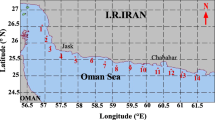Summary
Actinomycetes were isolated from sediments obtained from the Hudson River. Pretreatments utilized to improve the recovery of these microorganisms included heat and exposure to phenol or benzalkonium chloride. In addition, plating of sediment samples on selective agar substrates was also employed. These pretreatments eliminated or severely limited the growth of contaminating microorganisms thereby facilitating the isolation of actinomycetes. Of 165 isolates obtained, 22 exhibited significant antimycotic activity following growth in submerged culture. Among the test fungi examined, Candida krusei and Trichoderma viride proved to be the most susceptible to the active substances present in the fermentation broths. All but three of the latter contained polyenes. With one exception, the bioactive actinomycetes were identified as streptomycetes.
Similar content being viewed by others
References
Becker B, Lechevalier MP, Gordon RE, Lechevalier HA (1964) Rapid differentiation between Nocardia and Streptomyces by paper chromatography of whole cell hydrolysates. Appl Microbiol 12:421–423
Bormann C, Huhn W, Zahner H (1985) Metabolic products of microorganisms. 228 New nikkomycins produced by mutants of Streptomyces tendae. J Antibiotics 38:9–16
Cross T (1982) Actinomycetes: a continuing source of new metabolites. Develop Indust Microbiol 23:1–8
Goodfellow M, Haynes JA (1984) Actinomycetes in marine sediments. In: Ortiz-Ortiz L, Bojalil LF, Yakoleff V (eds) Biological, biochemical, and biomedical aspects of actinomycetes. Academic Press, New York, London, pp 453–472
Hamamoto T, Gunji S, Tsuji H, Beppu T (1983) Leptomycins A and B, new antifungal antibiotics. I. Taxonomy of the producing strain and their fermentation, purification and characterization. J Antibiotics 36:639–645
Hsu SC, Lockwood JL (1975) Powdered chitin agar as a selective medium for enumeration of actinomycetes in water and soil. Appl Microbiol 29:422–426
Ishimaru K, Ishida J, Noborio N, Nakamura S (1983) Histidinomycin, a new antifungal antibotic. J Antibiotics 36:1644–1650
Lawrence CH (1956) A method for isolating actinomycetes from scabby potato tissue and soil with minimal contamination. Can J Botany 34:44–47
Medoff G, Brajtburg J, Kobayashi GS (1983) Antifungal agents useful in therapy of systemic fungal infections. Ann Rev Pharmacol Toxicol 23:303–330
Nonomura H, Ohara Y (1969) Distribution of actinomycetes in soil. VI. A culture method effective for both preferential isolation and enumeration of Microbispora and Streptosporangium strains in soil (Part I). J Ferment Technol 47:463–469
Okami Y (1986) Marine microorganisms as a source of bioactive agents. Microbial Ecol 12:65–78
Omura S, Tanaka Y, Nakagawa A, Iwai Y, Inoue M, Tanaka H (1982) Irumamycin, a new antibiotic active against phytopathogenic fungi. J Antibiotics 35:256–257
Pisano MA, Sommer MJ, Lopez MM (1986) Application of pretreatments for the isolation of bioactive actinomycetes from marine sediments. Appl Microbiol Biotechnol 25:285–288
Rowbotham TJ, Cross T (1977) Ecology of Rhodococcus coprophilus and associated actinomycetes in fresh water and agricultural habitats. J Gen Microbiol 100:231–240
Sasaki T, Furihata K, Shimazu A, Seto H, Iwata M, Watanabe T, Otake N (1986) A novel macrolide antibiotic, notonesomycin A. J Antibiotics 39:502–509
Soliveri J, Arias M-E, Laborda F (1987) PA-5 and PA-7, pentaene and heptaene macrolide antibiotics produced by a new isolate of Streptoverticillium from Spanish soil. Appl Microbiol Biotechnol 25:366–371
Takatsu T, Nakayama H, Shimazu A, Furihata K, Ikeda K, Furihata K, Seto H, Otake N (1985) Rustimicin, a new macrolide antibiotic active against wheat germ stem rust fungus. J Antibiotics 38:1806–1809
Tunac JB, Graham BD, Dobson WE, Lenzini MD (1985) Fermentation by a new daunomycin-producing organism, Streptomyces insignis ATCC 31913. Appl Environ Microbiol 49:265–268
Uramoto M, Shen Y-C, Takizawa N, Kusakabe H, Isono K (1985) A new antifungal antibiotic, phosphazomycin A. J Antibiotics 38:665–668
Veiga M, Fabregas J (1983) Tetrafungin, a new polyene macrolide antibiotic. I. Fermentation, isolation, characterization, and biological properties. J Antibiotics 36:770–775
Author information
Authors and Affiliations
Rights and permissions
About this article
Cite this article
Pisano, M.A., Sommer, M.J. & Brett, B.P. Hudson River sediments as a source of actinomycetes exhibiting antifungal activity. Appl Microbiol Biotechnol 27, 214–217 (1987). https://doi.org/10.1007/BF00251947
Received:
Accepted:
Issue Date:
DOI: https://doi.org/10.1007/BF00251947




